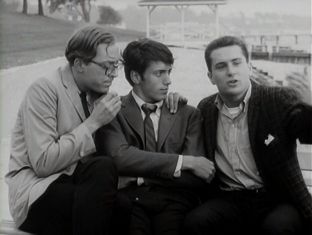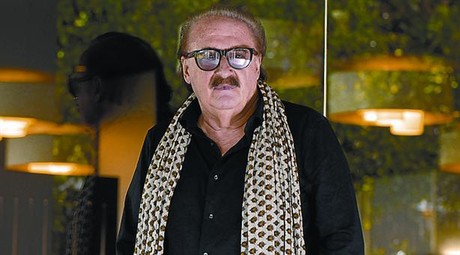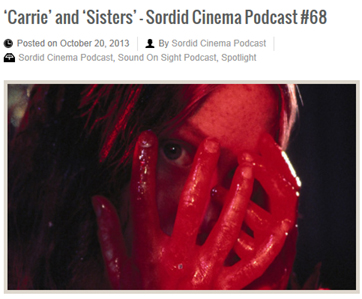MORE REVIEWS OF ARROW'S 'FURY' BLU-RAY
CARLOTTA WILL RELEASE ITS OWN BLU-RAY NOV. 8 IN FRANCE Arrow Video
Arrow Video's Blu-Ray edition of
Brian De Palma's
The Fury is set for release this Monday. Meanwhile, France's Carlotta Films will release its own Blu-Ray edition on November 8th, with the same disc features as the Arrow release, and an added introduction from
Samuel Blumenfeld. The covers of the Carlotta releases have been excellent, and their cover for
The Fury, shown here, is no exception.
Reviews are popping up all over for the Arrow release, and the general consensus is that this is a phenomenal release, and that the image transfer is a marked improvement over Twilight's release from earlier this year. Here are some of the reviews:
Mike Sutton, The Digital Fix
"De Palma dazzles us from the opening machine gun attack on Sanza and his son right through to the extraordinary ending (borrowed from Antonioni's Zabriskie Point but with a typical blackly comic twist). Shot after shot is inventive and witty so that you're entertained even when the plot is falling apart in front of you. From the whirling dervish camerawork - particularly good in the early test of Gillian's powers at school when a flash-forward is intercut to shocking effect - to the showy tracking shots and the daring process work, this is the work of an artist who has begun to trademark his own cinematic vision - De Palma is one of a handful of modern American directors whose films are immediately recognisable from a couple of shots. At his best, he is one of the greats. Take as an example the scene where Gillian and Hester (Snodgrass), Sanza's girlfriend, attempt an escape from the Institute. De Palma doesn't simply use slow motion to heighten the suspense, he uses slightly different speeds so each character seems to be existing in their own time-frame. We have the two women running, both with their own agendas, the hit men waiting, Peter Sanza wanting to capture Gillian, the government agents waiting in the car... This means that when the disaster comes it's both shocking and darkly ironic; note how Hester looks at her most joyously happy just as she is catapulted over the bonnet of a car. So much is packed into this scene and the key is that most of the impact is emotional rather than visceral, all the more so for it being largely backed by the score alone rather than sound effects."
About the Disc:
"The transfer of the film is, quite simply, a triumph. It’s a full restoration from the original camera negative supervised by James White, while the Blu-Ray is authored by David Mackenzie – technical wizards both, with a passion for cinema and a reliable gut feeling for how a film should look. The result is quite beautiful and an improvement in all areas on the previous Blu-Ray release. Colours are rich and full, especially the all-important blood reds, and the detail is breathtaking. If you simply look at the opening scene then you can see the water droplets on the Sanzas’ skin, the texture of the fabric of the blue tablecloth and even, god help us, the fine hairs on Kirk Douglas’ legs. Things that I never really registered before suddenly leap out – the awful wallpaper in Amy Irving’s bedroom for example. There’s still a lot of grain in places but that’s characteristic of every version of the film that I’ve ever seen and the occasional darkness of the image is, again, integral to the original photography. Indeed, the car-chase in the dark is a revelation here, although the high level of detail does tend to make the process work stand out. Fans of the film will be pleased to know that those great set-pieces look even better in this transfer, particularly the splendidly baroque climax where the constituent parts of the exploding body are much more clearly defined than before."
On the Extras:
"There are plenty of extras on the disc, most of them provided by Robert Fischer’s Fiction Factory. The most substantial is The Fury: A Location Journal, a fifty minute piece with Sam Irvin who worked as an intern on the film and wrote an account of the making for Cinefantastique magazine. He admits to having only recently seen the film again and is remarkably pleased with how well it holds up. His memory of the shooting is excellent and he has a lot of interesting anecdotes about meeting with De Palma and John Cassavetes – noting that the latter may have disliked making the film but that he gave his all to it once he signed the contract and made some significant contributions to the development of the character. I also liked his description of how Kirk Douglas would be in his trailer between scenes, doing push-ups. He also discusses the changes from the script to the finished film.
"There are two other new interviews on the disc. The first is with Fiona Lewis, entitled Spinning Tales. During this 14 minute chat she discusses her work on the film and her feelings about working with de Palma and some of her other directors including Roman Polanski. The second, Blood on the Lens, is a piece featuring DP Richard H. Kline whose work also includes Body Heat, The Boston Strangler and Star Trek: The Motion Picture. He has a lot to say about the way the film was shot and discusses the scenes which combine location and stage shooting. He considers the film to be his best work and I think he’s probably right. Although pretty old now – his career goes back to Columbia B-movies in the early 1940s – he is very eloquent and has a good memory. It’s a delight to listen to his instructive and entertaining reminiscences.
"Particularly interesting is the inclusion of Sam Irvin’s short film Double Negative which he made with some actors familiar from De Palma’s work including the great William Finley and co-operation from the great man himself. It was shown in the USA alongside After Hours and gained considerable critical plaudits. It’s intended as, in Irvin’s words, a 'valentine to Brian De Palma who gave me my start in the business' and is very entertaining with many nods to De Palma’s work and some clever bits of technique."
Ken Kastenhuber, McBastard's Mausoleum
"As with all of the recent Brian De Palma Blu-rays from Arrow we have a nice selection of Fiction Factory produced extras beginning with Blood on the Lens (27:00) an interview with Cinematographer Richard H. [Kline. He] speaks fondly of his only film with De Palma, remembering his experience on the set, setting-up shots, De Palma meticulous nature and commenting on the gorgeous cast, John Williams score and going into details about the specific scenes like the carnival sequence and the levitation scene.
"Up next is Spinning Tale (13:38) with star Fiona Lewis who remembers the film as being ahead of it's time and bearing the distinct De Palma stamp. She speaks briefly about her time on Roman Polanski's The Fearless Vampire Killers and A Day at the Beach with Peter Sellers and not wanting to do the film after reading the script until she met with De Palma, who impressed her. She offers some great recollections of working with John Cassevetes who was cold and dry witted, working with Andrew Stevens and being battered over the course of 24 takes of being thrown to the ground repeatedly.
"The most in-depth and rounded of the features would be The Fury - A Location Journal: An interview with Sam Irvin (49:49), who at the time of the film was intern and correspondent for Cinefantastique magazine. His recounting of his De Palma fandom and time on set working with the director and interviewing the cast is fantastic and offered a lot of behind-the-scenes info ranging from stealing the estate location from the Omen II production,the make-up effects, cut scenes, and differences between the book and film. Irvin is an unabashed De Palma groupie and was totally in love with Fiona Lewis, he would go onto direct and produce quite a few films of his own including Elvira's Haunted Hills and Gods and Monsters, the entire feature is quite a love-letter to De Palma and his film.
"Also included is Sam Irvin's Brian De Palma-esque short film Double Negative (17:58) a noir crime thriller about the film industry, fun stuff."
Dr. Svet Atanasov, Blu-Ray.com
•The Fury: A Location Journal - a very long and very informative interview with Sam Irvin, intern on The Fury, author of the film's shooting diary and correspondent for Cinefantastique magazine. Mr. Irwin recalls his first encounter with Brian De Palma, his trip to Chicago and interactions with the cast (and specifically his conversations with John Cassavetes), how and where key scenes from the film were shot, and the first negative reviews of The Fury. Mr. Irwin also discusses John Williams' score. The interview was directed, produced, and edited by Robert Fischer for Fiction Factory. In English, not subtitled. (50 min).
•Spinning Tales - in this video interview, actress Fiona Lewis (Dr. Susan Charles) discusses her contribution to The Fury and Brian De Palma's directing methods. Mrs. Lewis also comments on a scene she had with Kirk Douglas which was cut from the final version of The Fury. The interview was directed, produced, and edited by Robert Fischer for Fiction Factory. In English, not subtitled. (14 min).
•Blood on the Lens - in this video interview, cinematographer Richard H. Kline (King Kong, The Boston Strangler) recalls his one and only collaboration with Brian De Palma on The Fury. The interview was directed, produced, and edited by Robert Fischer for Fiction Factory. In English, not subtitled. (27 min).
•Double Negative - a short film tribute to Brian De Palma directed by Sam Irwin in 1985, starring Bill Randolph, Dori Legg, and Justin Henry. In English, not subtitled. (18 min).
The following text provided by Sam Irwin precedes the film:
"Double Negative is a valentine to Brian De Palma who gave me my start in the business. I interned for Brian on The Fury, associate produced his next film Home Movies, and assisted him on Dressed to Kill. Utilizing actors and crew I had met during my De Palma years, I wrote, produced, and directed my debut film Double Negative. Graciously, Brian let me use his editing facilities for free. The film was an official selection of the 1985 Sundance Film Fesitval and played theatrically in New York and Los Angeles. New York Times film critic Janet Maslin wrote that the film was 'an exceptionally promising film effort'".
Mondo Digital
"Considering the importance of its visuals, home video has had a very uneven track record with The Fury over the years. Like Carrie, the film was composed for 1.85:1 projection but shot open matte, and the initial VHS and laserdisc editions were released unmasked at 1.33:1. That framing destroyed the focus of several significant shots, especially the spinning death of one character near the end, and the initial transfers suffered from oversaturated, orange skin tones and a generally murky, ugly look. Originally released in mono, The Fury was given something of an audio revamp for its DVD bow from Fox in 2001 for a 4.0 surround track. That largely means the sound effects and score get shoved over to the front speakers, though some ambient sound carries to the rear as well. The mix often sounds strained and artificial, but if you want the audio to fill more of speakers, it's a passable effort. That disc also includes a bombastic three minute theatrical trailer and a small gallery of photos, including a funny, oft-printed outtake shot of the final scene. Those extras were carried over the limited (3,000 unit) Blu-ray from Twilight Time in mid-2013, which includes an improved (though still imperfect) HD transfer that looks similar to a good 35mm print (but more on that in a moment). The lossless audio for both the 4.0 and mono options sounds very rich, and Williams' score is also included as an isolated track for good measure.
"That brings us to the second Blu-ray release, a UK special edition from Arrow Video that marks their fourth De Palma release after Obsession, Dressed to Kill, and Blow Out. Interest was piqued immediately when the label announced their transfer was not the same one used for the Twilight Time release; instead they were commissioning a new one from the original camera negative, the first time ever for this title. Thankfully their efforts have more than paid off with a powerhouse video presentation that easily blows its predecessors to pieces, removing the veneer of grime, noise, and grit that was once thought to be a part of its basic aesthetic. The grungy skin tones of the most problematic scenes (Irving's intro scene and the fingernail scratching cross cutting in particular) look far more natural now, and the film as a whole is much easier to enjoy. Interestingly, the framing is also very different and better judged, dropping some extraneous headroom to expose more at the bottom (while adding a great deal to left and losing a marginal amount on the right), creating a slightly more centered composition for the film as a whole. Black levels are also much deeper and richer, which creates a far greater sense of depth and atmosphere...
"The English audio is presented as usual in the same 4.0 and 2.0 mono DTS-HD mixes, with the isolated track included along with optional English subtitles. The trailer pops up again, of course, but the Arrow release really excels with the rest of the extras including some invaluable video featurettes that should make De Palma fans giddy. First up, ace cinematographer Richard H. Kline takes center stage for the 27-minute 'Blood on the Lens,' talking in detail about working with De Palma and advancing the split diopter photography he first introduced in The Andromeda Strain. He also talks about jumping onto this film while he was still in production on Karel Reisz's Who'll Stop the Rain, but the main focus here is on his sole collaboration with De Palma, which ranks among the best work either of them ever achieved.
"Equally good is 'Spinning Tales' (13 mins.), a chat with Fiona Lewis (a blonde!) about her overall career including a few highlights like The Fearless Vampire Killers, A Day at the Beach, Lisztomania, and Drum. (Dr. Phibes Rises Again fans will get gypped though.) It's fascinating to hear about her career, which really should have been bigger in the '80s, and her stories about making The Fury are fascinating (especially her initial reluctance to accept the role) and, in one instance, horrifying (as she describes a deleted attempted rape scene, during which she banged her head for real over and over again). Then brace yourself for the 49-minute "The Fury: A Location Journal," with De Palma acolyte Sam Irvin (now a director in his own right starting with Guilty as Charged) walking through his experience on the set for eight days, which he recounted for Cinefantastique magazine. Among the highlights are his memories of getting Irving to publicly admit her relationship with Steven Spielberg for the first time, the special effects work of Rick Baker and William Tuttle (with a little involvement from Dick Smith), the original casting choices for the old couple eventually dropped from the script, and the filming of an additional, nasty grace note for one character's death, which was cut from the film but would have actually been more satisfying (as well as closer to the source novel). You'll also find out about a quick cameo from producer Frank Yablans and a very funny technical gaffe in the cafeteria scene, specifically behind a young Daryl Hannah. He then recounts sitting in on the film's postproduction process and getting a gig on De Palma's next film, the hilarious film school experiment Home Movies. (And for the love of God, could someone please, please release a decent home video version of that one already?) Irvin's first short film, Double Negative, is also included from what appears to be an older tape source; it's a fun little 17-minute De Palma homage (with William Finely again!) about a film student with a bit of a personality disorder."
 In a Telegraph article posted Friday ahead of tomorrow's release of Brian De Palma's The Fury on Blu-Ray, Sam Irvin shares memories of his internship on the film. Here is an excerpt:
In a Telegraph article posted Friday ahead of tomorrow's release of Brian De Palma's The Fury on Blu-Ray, Sam Irvin shares memories of his internship on the film. Here is an excerpt:



 Thanks to Rado for sending in this great interview with Robert De Niro, conducted by
Thanks to Rado for sending in this great interview with Robert De Niro, conducted by  Somehow I had missed this magnificent interview with P.J. Soles from last week, posted by
Somehow I had missed this magnificent interview with P.J. Soles from last week, posted by  Brian De Palma's Sisters, which had a remake of its own a few years ago, is included in
Brian De Palma's Sisters, which had a remake of its own a few years ago, is included in  The cover art for Arrow Video's upcoming Phantom Of The Paradise Blu-Ray was revealed today. The release is available for preorder on the
The cover art for Arrow Video's upcoming Phantom Of The Paradise Blu-Ray was revealed today. The release is available for preorder on the 

 Brian De Palma's Redacted had its world premiere at the 2007 Venice Film Festival, yet never opened there theatrically. It gets a rare public screening tonight at the
Brian De Palma's Redacted had its world premiere at the 2007 Venice Film Festival, yet never opened there theatrically. It gets a rare public screening tonight at the  On the latest
On the latest 